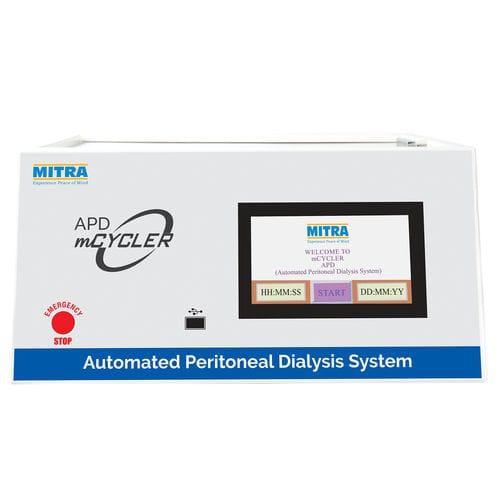
Home care peritoneal dialysis machine APD m.Cyclerportablewith touchscreen

Add to favorites
Compare this product
Characteristics
- Type
- home care
- Options
- portable, with touchscreen
- Weight
13.3 kg
(29.3 lb)- Width
450 mm
(17.7 in)- Length
460 mm
(18.1 in)- Height
250 mm
(9.8 in)
Description
Give freedom of time to dialysis patients & freedom from manual exchanges.
Design:
• Height adjustable stand for various patient position option
Advanced Technology:
• Integrated heating system for cold climatic conditions
• Easy to use Touch Screen interface
Safety Functions:
• Pre-attached tubing & drain bag (100% sterile & closed system)
• Unique emergency STOP, which re-starts from the stop sequence
Data Management:
• USB flash drive compliant (Transfer/visualize patient exchange data on desktop
Specifications & Features
External memory support type USB host
Internal memory support 99 therapy histories for six patients each. Total history memory for 594 therapies maximum.
Supported therapies • NIPD • CCPD • CCPD+ • IPD • Tidal PD
Display Type 7” TFT LCD display; Color touch screen
Intended use Automated Peritoneal Dialysis for renal patients
VIDEO
Catalogs
Related Searches
- Laboratory filter
- Sterile filter
- Blood filter
- Blood bag
- PVC blood bag
- Leukoreduction filter
- CPDA-1 blood bag
- CPD blood bag
- Single blood bag
- Quadruple blood bag
- Blood bank filter
- Red blood cells filter
- Triple blood bag
- Double blood bag
- Whole blood filter
- Blood plasma blood bag
- Platelet blood bag
- Red blood cell blood bag
- ISO 3826 blood bag
- Blood bag filter
*Prices are pre-tax. They exclude delivery charges and customs duties and do not include additional charges for installation or activation options. Prices are indicative only and may vary by country, with changes to the cost of raw materials and exchange rates.



